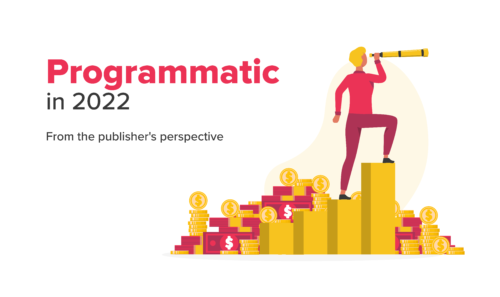What Have First-Price Auctions Changed for Publishers?
After a long period of testing small inventory sections, on September 26 Google fully transitioned to the First-Price Auctions. This means that from now on, space will be purchased for the price at which it is auctioned by the advertiser and will not be reduced to the second-highest bid. Of course, this gave rise to many questions, such as ‘What does it actually mean for publishers?’ and ‘How will it change the programmatic market?’
Is there anything to fear?
When the news about First-Price Auctions was first announced, people started speculating how this would change the situation on the programmatic market. The greatest fear was so-called Bid Shading, which, in brief, is an algorithm responsible for bidding strategy.
As in theory, it is supposed to allow purchasing views for the lowest possible price, it was hypothesized that the value of publishers’ inventory would degrade over time. One line of defense against this phenomenon is pricing one’s advertising space in GAM, although the greatest yield should theoretically be achieved at a zero rate. But is that true?

Unfortunately, it usually is. In most cases, the best rCPM result is achieved at a zero rate, which can, however, cause drops in the long-term analysis. Nevertheless, Target CPM can help us increase revenue even if we have set floor prices.
Optimization in the First-Price era
Google has already retired the option of setting conventional pricing rules with Anonymous and Branded rates. This option was replaced by Unified Pricing Rules, where only Branded rates may be applied. One important difference is that they are no longer limited to the Open Market, but they encompass all lines and line items with priority 12, that is, among other things, Open Bidding and Header Bidding. In consequence, it is easy to accidentally block the Price Priority or Network campaign due to rules being priced too high.
Long before unified pricing rules were introduced, we were given access to one more functionality, i.e. Target CPM. A price rate set as Target CPM will allow lower bids so that profits are maximized while keeping the set CPM. When auctions were still conducted using the Second-Price model, the results of Target CPM and Price Rate were zero, but in the FP era, minor differences became noticeable.

In a selected part of the inventory, the traffic was equally divided between rules with a floor price and Target CPM. Due to its method of operation, Target CPM is able to achieve greater coverage and revenue with request CPM being the same or better. If you do not care about setting CPM floor prices, then this solution may be a good alternative.
How has Header Bidding changed?
By combining data from a broad geo range, we were able to determine how the distribution of forces in HB changed at a global level.
The increase of Criteo’s share in daily revenue, which is similar to OpenX and RTB House, is particularly noticeable among the distinctive trends.

Naturally, drops were unavoidable – a visible downward trend has been noted in relation to AppNexus:

Do you like what you’re reading? Subscribe our newsletter for more content like this!
Changes in demand channels
The demand channel report shows the method used by buyers to get access to your inventory. Ad Exchange, Ad Server and Exchange Bidding (currently Open Bidding) account for the vast majority. In our report, the Ad Server channel includes Header Bidding only. For the data to be deemed as presenting the average market change, we combined the data from a total of seven DFP accounts.

During the first few days following the transition to First-Price Auctioning (September 26–28), the share of Ad Exchange in the total revenue dropped by a few percentage points but increased shortly after and now shows an upward trend. Header Bidding did not incur a significant loss, as the change is happening at the expense of Exchange Bidding. Based on the above data, it can be concluded that the transition to First-Price Auctioning changed the distribution of forces in Google’s favor.
A look at the CPM rates reveals that they mostly increase evenly in relation to one another:
First Price triggered a short-term increase of the CPMs, which, after a few days, started gently decreasing. Nevertheless, it is still at a higher level.
AdWords and its place on the Open Market

Analyses of the distribution of the buyer network on the Open Market usually indicate that AdWords accounts for both most views and revenue. AdWords (currently Google Ads) is an advertising system that allows ads to be displayed in the Google network: in the search engine, maps or partners’ networks. We already know that the Ad Exchange is gaining more and more space. Does this mean that AdWords is in a privileged position?
As it turns out, to a certain extent, it is.

The graph above illustrates changes in revenues (columns) and the CPM rate (line) since May 2019. Both those metrics show an upward trend and AdWords itself is increasing its share in the Open Market:

The change is slight, but nevertheless noticeable. Before September, AdWords’ share on the Open Market did not exceed 80% of all views, while after September 26–28, its share has oscillated around that value and slightly exceeded it.
TL;DR
Google’s long-awaited transition took place on September 26 and resulted in a series of changes. Standard pricing rules were replaced with unified pricing rules, which outside of the Open Market impact all line items with priority 12 (including HB and Open Bidding).
When pricing an advertising space, one must now be careful not to block active campaigns. To additionally aid the maximization of revenue from space under a pricing rule, we received Target CPM, which allows lower bids to win while simultaneously maintaining the desired CPM.
Aside from Open Market and pricing rules, First-Price Auctioning introduced certain changes to numerous other aspects of the programmatic market. Starting from Header Bidding, there are platforms that have gained from this situation, such as Criteo or OpenX, and some that have incurred potential losses, such as AppNexus.
Moreover, by increasing the share of Ad Exchange in the demand channels at the expense of Open Bidding and Header Bidding (to a small extent), Google has also changed the distribution of forces. The increase of AdWords’ share on the Open Market, as well as its revenue and the CPM rate, are directly related thereto. An analysis of particular demand channels’ CPMs reveals a temporary increase, which, however, normalized at the beginning of October. As First-Price Auctioning is a new phenomenon, it is impossible to say whether certain trends will persist.






